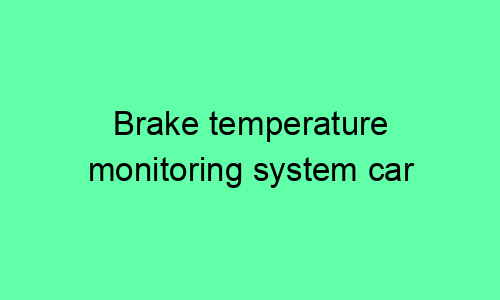Brake Temperature Monitoring System for Cars
Introduction
Brakes are an essential safety component of any car. They allow drivers to slow down or stop the vehicle as needed. However, brakes can also overheat, which can lead to a number of problems, including reduced braking performance, brake fade, and even brake failure.
A brake temperature monitoring system can help to prevent these problems by warning the driver when the brakes are overheating. This can give the driver time to take corrective action, such as slowing down or stopping the vehicle to allow the brakes to cool down.
How a Brake Temperature Monitoring System Works
A brake temperature monitoring system typically consists of a sensor that is mounted on the brake caliper. The sensor measures the temperature of the brake pads and sends the information to a display in the car’s dashboard. The display will typically show the temperature of each brake pad, as well as a warning light that will illuminate if the brakes are overheating.
There are two main types of brake temperature sensors: contact sensors and non-contact sensors.
- Contact sensors are mounted directly on the brake pads. They measure the temperature of the pads by making contact with them.
- Non-contact sensors are mounted near the brake pads. They measure the temperature of the pads by sensing the infrared radiation that they emit.
Benefits of a Brake Temperature Monitoring System
There are a number of benefits to having a brake temperature monitoring system in your car.
- Prevents brake overheating – A brake temperature monitoring system can help to prevent brake overheating by warning the driver when the brakes are getting too hot. This can give the driver time to take corrective action, such as slowing down or stopping the vehicle to allow the brakes to cool down.
- Improves braking performance – Brakes that are overheating can experience reduced braking performance. A brake temperature monitoring system can help to prevent this by warning the driver when the brakes are getting too hot, so that they can take corrective action.
- Prevents brake fade – Brake fade is a condition that can occur when the brakes are overheated. Brake fade can cause the brakes to lose their effectiveness, which can be dangerous. A brake temperature monitoring system can help to prevent brake fade by warning the driver when the brakes are getting too hot, so that they can take corrective action.
- Prevents brake failure – In extreme cases, brake overheating can lead to brake failure. Brake failure can be catastrophic, as it can cause the driver to lose all control of the vehicle. A brake temperature monitoring system can help to prevent brake failure by warning the driver when the brakes are getting too hot, so that they can take corrective action.
Conclusion
A brake temperature monitoring system is a valuable safety device that can help to prevent brake overheating, improve braking performance, prevent brake fade, and prevent brake failure. If you are looking for a way to improve the safety of your car, a brake temperature monitoring system is a good investment.






